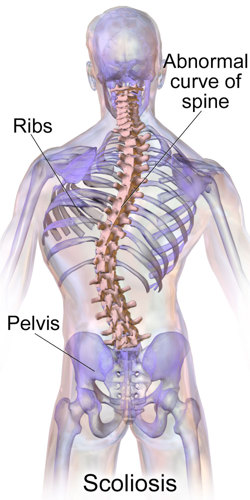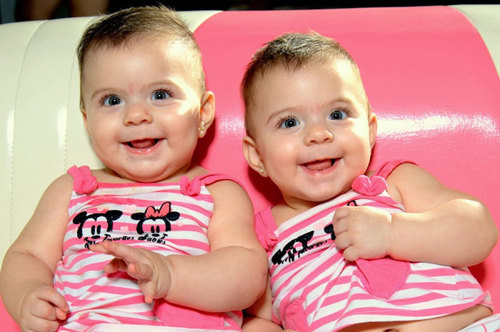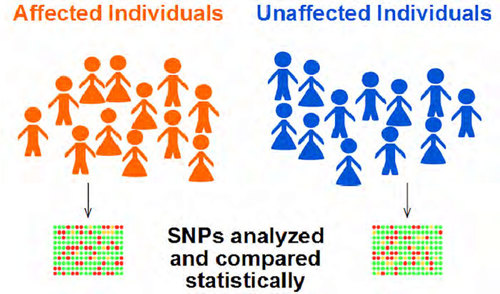
Is there any proof that scoliosis is hereditary?
November 8, 2016

- Related Topics:
- Complex traits,
- Genetic conditions,
- Environmental influence
A curious adult from Idaho asks:
“Is there any proof that scoliosis is hereditary?”
Great question, the answer seems to be yes! We know that some types of scoliosis are at least partly hereditary.
There’s much more to the story, though. As you can probably tell from that sentence, the sideways curvature of the spine that is scoliosis is not that simple to figure out.
Now we need to be careful here. Some scoliosis is definitely genetic because it is part of a genetic syndrome like Marfan syndrome, Noonan syndrome, or Neurofibromatosis type 1.
But this probably isn’t what you’re asking about.
Instead we are going to talk about idiopathic scoliosis. This is the name when scoliosis is the only symptom. This also means it isn’t caused by something like a back injury.
Doctors have noticed for years that scoliosis runs in families. For example, if you have a close relative with scoliosis, you are more likely to have it too. The closer the relatives with scoliosis are to you, the greater your risk.
There was some research done on this in the 1960’s and 1970’s. First, they found that the risk for scoliosis in the general population was low. If you took 1000 people at random, 2-4 of them had it. The chances go up a lot if someone had a parent or a sibling with the condition. If you got 1000 people with first degree relatives like these with scoliosis, somewhere around 70-110 of them would have it [1]. That is a big change!
These kinds of numbers don’t necessarily mean scoliosis is genetic. Maybe these families just share something in common like a certain diet that is the actual cause.
That’s why scientists turned to twin studies next.

“How Genetic” Is Scoliosis?
Next, scientists want to figure out if the patterns we see in families are caused by genetics or something else, like the environment. To do this, they compare fraternal and identical twins.
Identical twins have identical DNA, but fraternal twins don’t. If something is 100% genetic, we should see identical twins both having the condition 100% of the time.
Let’s say Sara and Kelly are identical twins. If Kelly has a condition that’s purely genetic, then Sara will always have it too. Now if Sara has a condition and Kelly doesn’t, then it isn’t purely genetic. We then consider whether the environment plays a role.
For scoliosis, these types of twin studies found lots of different percentages. The percent of the time that identical twins both had scoliosis ranged from 13% of the time to 73% of the time.[2] So we know that genetics isn’t everything with scoliosis since this number wasn’t 100%. So sometimes Sara had scoliosis and Kelly didn’t.
Of course this doesn’t tell us if scoliosis is genetic at all. Twins usually develop and grow in the same environment. To see if scoliosis is genetic, we compare the results to fraternal twins.

Fraternal twins only share about half of their DNA, just like any other siblings. So if two twins in a fraternal pair and two twins in an identical twin pair have the same percentages, then we know that scoliosis is purely environmental. But researchers didn’t find this.
Instead, fraternal twins both had scoliosis only 0-36% of the time. This is less than the 13-73% we saw with identical twins. These numbers overlap a lot. However, these numbers are from many different studies. In every study, it seemed the percentages for fraternal twins were lower than those for identical twins.
So we know that scoliosis isn’t just caused by the environment. There are some genetic influences too.
Overall, it looks like scoliosis is caused by a combination of genetics and environment.
Family Patterns and Looking for Genes
Scientists also tried to come up with an inheritance pattern for the condition. To do this, we can look at who in a family has a disease and who it gets passed to.
For scoliosis, they didn’t see a pattern in most families. And the ones they did see were all over the place.
In some families, it looked like people were passing down scoliosis to individuals in every generation. In others, it looked like scoliosis skipped generations and was only sometimes passed from mothers to their sons.
In some cases, the researchers used these patterns to figure out what genes were causing the scoliosis in each family. Some of these studies traced the cause to a gene that may be important for spine development. This makes perfect sense for scoliosis.
But this doesn’t explain why scoliosis develops in most cases. Most likely it happens in lots of different ways in different families.
What other genes have been linked to scoliosis?
Even though we saw scoliosis running in many families, scientists still couldn’t figure out what genes caused it in most cases. Scientists looked at this and said, maybe lots of genes work together to cause scoliosis!
How do we study this? Scientists can do what are called genome-wide association studies, or GWAS. By doing this, scientists can identify multiple genes that are causing the condition (click here for more on how these studies work)

Scientists first take a bunch of different people with and without a genetic condition. Then they look at their genetic make-up. Then they compare the genetic differences in the people with the condition to the people without the condition.
Let’s say, everyone in the group with the condition has a certain genetic change. But no one in the group without the condition has that change. If we have enough people in the study, then we can say that change is important and probably causes the condition.
We can find many different genes for scoliosis this way. Some of the genes that have been found through this kind of study are also involved in spine growth. Other genes influence bone and muscle growth near the spine.
When many different genes contribute to a condition, it is called a complex genetic disorder. For scoliosis, we know many genes may work together to determine whether someone will get scoliosis or not.
But these genes are nowhere near explaining all the cases of scoliosis we see. Why is this?
Well first off, environmental effects can muddy the waters. Imagine two people who have the same thing in their DNA that can lead to scoliosis but only one has scoliosis. Maybe the second person didn’t have anything in their environment to trigger it.
Now when you compare the two of them, you won’t be able to see the genetic difference that led to scoliosis. Both have it, but you didn’t find it in the study.
For scoliosis, we know from GWAS that many genes may work together to cause scoliosis. [3] But we know we didn’t find all the genes because of possible environmental causes that work with the genetic causes.
The Big Picture
So scoliosis isn’t clearly genetic or environmental. Both probably play a role in who develops scoliosis. This is called multifactorial inheritance, when both environment and genetics matter.
As you can tell, it’s hard for researchers to tease out genetics from influences in the environment. The genetics of scoliosis is not a well-studied area. Even so, there’s still hope that scientists will be able to use those families with lots of people with scoliosis to figure out how scoliosis is inherited. Stay tuned!

Author: Karina Liker
When this answer was published in 2016, Karina was a student in the Stanford MS Program in Human Genetics and Genetic Counseling. Karina wrote this answer while participating in the Stanford at The Tech program.
 Skip Navigation
Skip Navigation
